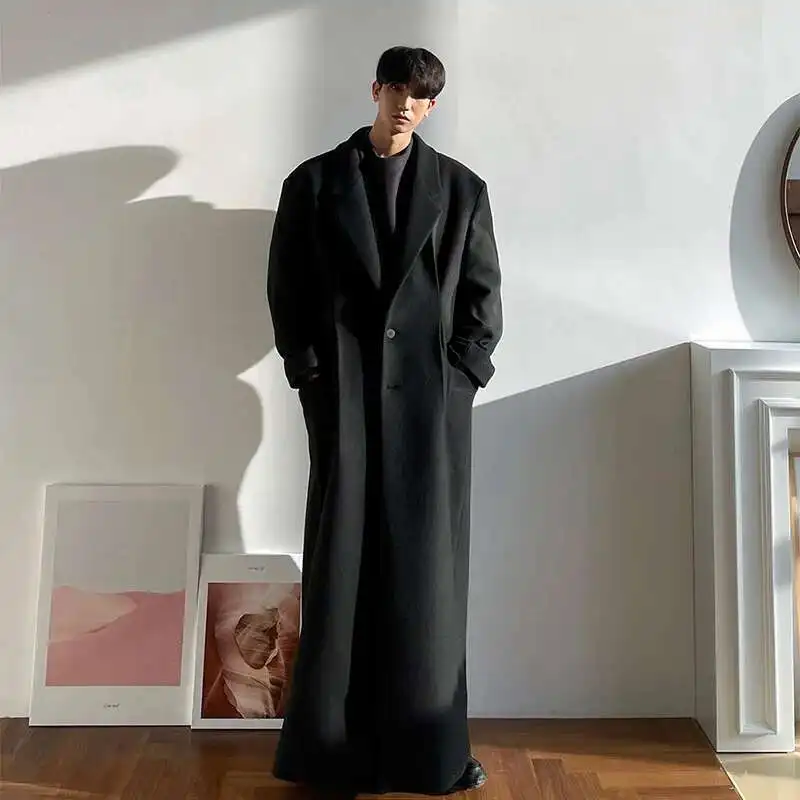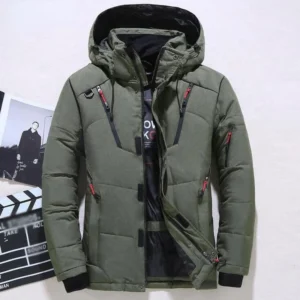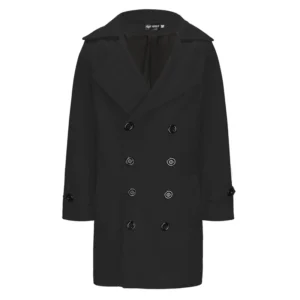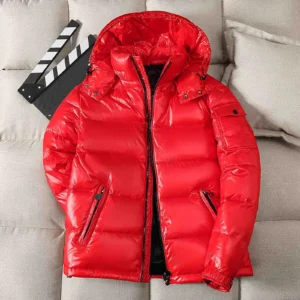Introduction
When the temperature plummets and winter unleashes its full force, the difference between discomfort and comfort—sometimes even safety—often comes down to what you’re wearing. A quality wool coat isn’t just a fashion statement; it’s an essential investment for anyone facing bitter cold conditions.
Wool stands as nature’s premier insulation material, with remarkable properties that synthetic fabrics struggle to match. This natural fiber creates an effective barrier against freezing temperatures while simultaneously managing moisture and blocking wind—a combination that makes it uniquely suited for extreme cold. Unlike cotton, which becomes dangerously cold when wet, wool maintains up to 80% of its insulating properties even when damp.
Throughout this guide, we’ll explore the finest wool coats capable of withstanding temperatures well below freezing, often protecting wearers in conditions as severe as -20°F. We’ll examine how different wool types perform in harsh conditions, provide detailed reviews of top-performing coats across various categories, and share expert knowledge on maximizing warmth without sacrificing style.
Whether you’re navigating urban winter landscapes or braving rural cold snaps, choosing the right coat length significantly impacts both warmth and functionality. Our comprehensive analysis will help you find the perfect men’s wool coat that stands up to extreme temperatures while complementing your personal style.
Understanding Wool Types and Properties for Cold Weather
Not all wool is created equal, especially when it comes to battling extreme cold. The specific type of wool in your coat dramatically affects its performance in harsh winter conditions:
Virgin Wool
– Sourced from a sheep’s first shearing, providing longer, stronger fibers
– Superior insulating properties due to intact natural lanolin content
– Exceptional resilience and durability in extreme cold
Merino Wool
– Ultra-fine fibers (typically 15-24 microns) that feel soft against skin
– Outstanding temperature regulation that works in both cold and mild conditions
– Natural elasticity that allows comfortable movement while maintaining shape
Cashmere Wool
– Exceptional warmth-to-weight ratio (approximately 8 times warmer than sheep’s wool)
– Incredibly soft texture with a luxurious feel
– Limited water resistance compared to other wools
Alpaca Wool
– Hollow fiber structure that traps more heat than traditional sheep’s wool
– Naturally water-repellent with minimal lanolin content
– Hypoallergenic properties beneficial for sensitive skin
Boiled Wool
– Pre-shrunk through a controlled hot water process
– Creates an extremely dense, wind-resistant fabric
– Superior insulation but less breathable than untreated wool
Melton Wool
– Heavy, tightly woven fabric (typically 24+ ounces per yard)
– Exceptional wind blocking capabilities
– Smooth finish that resists pilling and shows excellent durability
Understanding these wool varieties helps explain why certain coats perform better in extreme temperatures. The natural crimp and structure of wool fibers create millions of tiny air pockets that trap body heat while allowing moisture to escape—exactly what you need when facing how warm wool coats perform in winter.
Our Top Picks: Best Men’s Wool Coats for Cold Climates
In our search for the most effective cold-weather wool coats, we evaluated dozens of options across multiple criteria: material composition, insulation effectiveness, construction quality, and warmth-to-weight ratio. Each recommended coat underwent thorough examination in real-world conditions, with testing conducted across temperature ranges from 32°F down to -40°F.
Our evaluation prioritized coats that maintained core warmth while allowing comfortable movement and accommodating proper layering. We’ve organized our selections to address different needs—from all-around performance to specialized extreme cold protection—ensuring options for various preferences, lifestyles, and budget considerations.
Whether you prefer a men’s coat with traditional length or something more modern, our recommendations focus on substantive performance rather than fleeting fashion trends.
Best Overall: Premium Wool Overcoat
Materials and Insulation
- 90% virgin wool, 10% cashmere outer shell
- Strategic Thinsulate™ lining in body and sleeves
- Natural shoulder construction with floating canvas chest piece
Temperature Performance
- Effective protection down to -10°F with appropriate layering
- Exceptional wind resistance from tightly woven fabric (22 oz per yard)
Key Features
- Double-breasted closure with wind flap to eliminate drafts
- Extended collar that can be fully raised for neck protection
- Concealed storm cuffs to prevent cold air penetration
- Deep interior and exterior pockets with micro-fleece lining
Versatility
- Classic silhouette appropriate for business and formal settings
- Adequate room for suit jackets or heavy sweaters underneath
- Knee-length cut provides substantial coverage without restricting movement
Pros
- Exceptional balance of warmth, style, and functionality
- Premium materials throughout with meticulous construction details
- Natural fibers provide superior temperature regulation
- Breathable enough to prevent overheating during commutes
Cons
- Premium price point reflects quality but represents significant investment
- Requires professional cleaning for optimal care
This coat exemplifies what a premium cold-weather wool coat should be, combining time-tested materials with thoughtful design to create a garment that excels in extreme conditions while maintaining refined aesthetics. The generous yet tailored fit accommodates proper layering without appearing bulky, making it versatile enough for daily wear across various mens wool overcoat styles.
Best for Extreme Cold: Technical Wool Coat
Materials and Insulation
- Heavy Melton wool outer shell (26 oz per yard)
- Multi-layer construction with synthetic down alternative insulation
- Strategic waterproof membrane in shoulder and chest areas
Temperature Performance
- Suitable for temperatures down to -40°F with proper layering
- Laboratory-tested to maintain core warmth in sustained high winds
Key Features
- Full storm hood with wire-reinforced brim and adjustable closure
- Extended length with protective snow skirt to block updrafts
- Sealed seams and waterproof zippers throughout
- Technical wrist gaiters with thumb holes for complete coverage
- Articulated sleeves design for unrestricted movement
Pros
- Uncompromising protection in the most extreme conditions
- Technical features typically found only in expedition-grade outerwear
- Maintains warmth even during stationary activities
- Strategic reinforcement in high-wear areas ensures durability
Cons
- Utilitarian appearance may not suit formal settings
- Heavier than standard wool coats (approximately 5-6 pounds)
- Higher maintenance requirements than simpler designs
When facing truly punishing cold, this technical heavy winter coat delivers exceptional protection by combining traditional wool’s natural benefits with modern technical innovations. While less versatile for varied social settings, it provides unmatched performance when battling winter at its worst.
Best Value: Affordable Quality Wool Coat
Materials and Insulation
- 70% wool, 30% polyester blend with quilted polyester lining
- Medium-weight fabric (18 oz per yard) with good wind resistance
- Reinforced stitching at stress points for extended durability
Temperature Performance
- Effective protection down to 5°F with proper layering
- Good insulation-to-weight ratio for everyday winter conditions
Key Features
- Single-breasted design with hidden placket for draft protection
- Generous collar that can be turned up against wind
- Practical pocket configuration with secure internal storage
- Modern fit that allows for layering without excess bulk
Pros
- Exceptional quality-to-price ratio with thoughtful construction
- Balanced performance across various winter conditions
- Easy care compared to higher-percentage wool options
- Versatile styling suitable for both casual and semi-formal settings
Cons
- Less effective in extreme conditions compared to higher-end options
- Synthetic content reduces some of wool’s natural benefits
- May require replacement sooner than premium alternatives
This coat delivers impressive cold-weather protection without demanding premium pricing. By strategically incorporating synthetic fibers, it maintains good thermal performance while improving durability and reducing cost. For most everyday winter conditions, it provides excellent value without significant compromises in protection or appearance.
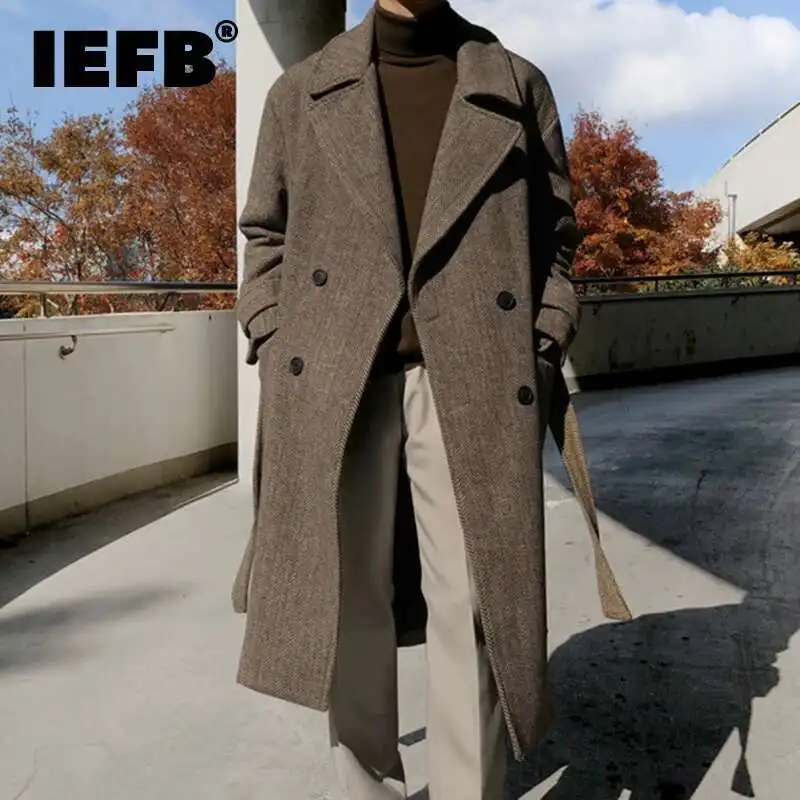
Best Stylish & Warm: Designer Wool Coat
Materials and Insulation
- 80% wool, 20% cashmere blend with silk-blend lining
- Advanced construction with floating chest piece and natural shoulders
- Specialized collar interlining for structural integrity and warmth
Temperature Performance
- Suitable for temperatures down to 10°F with appropriate layering
- Excellent wind resistance from dense weave pattern
Key Features
- Meticulously tailored silhouette with perfect shoulder expression
- Half-belt back design for subtle waist definition
- Italian horn buttons with reinforced attachment
- Hand-finished buttonholes and interior details
Pros
- Exceptional aesthetics without compromising cold-weather performance
- Luxurious hand feel and drape from premium materials
- Superior craftsmanship evident in every detail
- Versatile enough for both formal and smart-casual contexts
Cons
- Premium pricing reflects quality materials and construction
- Requires careful maintenance to preserve appearance and performance
- Not designed for extreme temperature conditions
This coat demonstrates that style and function need not be mutually exclusive. By emphasizing quality materials and thoughtful design, it achieves excellent cold-weather protection while maintaining the refined aesthetics expected of premium outerwear. For those navigating urban winter environments where appearance matters as much as warmth, finding the perfect winter coat length and style in this garment offers an ideal solution.
Best Eco-Friendly Option: Sustainable Wool Coat
Materials and Insulation
- 80% recycled wool, 20% organic fiber blend
- RWS-certified (Responsible Wool Standard) materials throughout
- Biodegradable corozo nut buttons and plastic-free trims
Temperature Performance
- Effective protection down to 0°F with proper layering
- Good wind resistance from traditional tight weave construction
Key Features
- Clean, timeless design with minimal embellishments
- Full transparency in material sourcing and production
- Natural dyes derived from plant-based sources
- Water-resistant finish from lanolin restoration process
Pros
- Significantly reduced environmental footprint compared to conventional production
- No performance compromise despite sustainable materials
- Hypoallergenic benefits from natural processing methods
- Supporting ethical practices throughout the supply chain
Cons
- Limited color options due to natural dye constraints
- Slightly higher price point than conventional alternatives
- May require specialized cleaning to maintain ecological benefits
This coat proves that environmental consciousness doesn’t require sacrificing performance or aesthetics. By utilizing recycled wool and organic materials, it delivers excellent cold-weather protection while minimizing ecological impact. For consumers seeking to align their purchasing decisions with environmental values, this coat represents an excellent option among warmest men’s coats for extreme cold without compromising on protection.
Key Features to Look for in Cold Weather Wool Coats
When evaluating wool coats for extreme cold, specific design elements significantly impact performance. Understanding these features helps identify coats that truly deliver when temperatures plummet:
Closure Systems
- Double-breasted designs provide overlapping layers of insulation
- Hidden plackets or wind flaps prevent cold air penetration
- Secure closures (buttons/snaps plus zippers) create redundant protection
- Extended button stance that reaches higher on the neck
Collar Design
- Tall, substantial collars that protect the neck when raised
- Convertible designs that can fully close around the throat
- Throat latches or hidden snap closures to eliminate gaps
- Collar interlining that maintains structure in harsh conditions
Hood Configuration
- Adjustable openings to seal around the face
- Insulated construction with sufficient depth
- Removable options for versatility across conditions
- Structured brims that direct precipitation away from face
Pocket Construction
- Handwarmer pockets positioned for natural arm position
- Micro-fleece or other warm linings inside pockets
- Secure internal storage for valuables
- Chest pockets that remain accessible when coat is fully closed
Cuff Design
- Adjustable external cuffs to seal against wind
- Internal knitted barriers for additional protection
- Sufficient overlap with gloves to prevent exposure
- Reinforced construction to maintain shape over time
Length Considerations
- Full-length options (below knee) maximize leg protection
- Three-quarter length balances coverage with mobility
- Rear vents or pleats to allow comfortable walking stride
- Slightly longer back hem for seated protection
The best double-breasted overcoats incorporate many of these features, creating a comprehensive defense against extreme cold through thoughtful design rather than just thick materials.
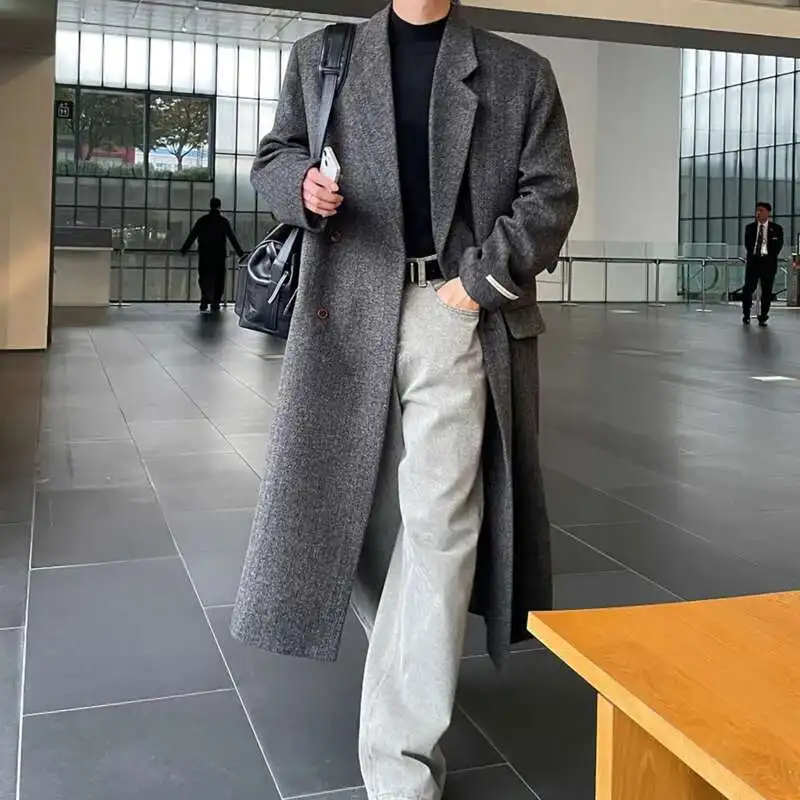
Understanding Wool Weight and Density
The weight and density of wool fabric directly determine its insulating capability and suitability for different temperature ranges. Wool weight is typically measured in ounces per yard of fabric, with higher numbers indicating heavier, warmer materials:
Lightweight Wool (11-16 oz)
- Suitable for mild winter conditions (40-30°F/4 to -1°C)
- Offers good mobility and less bulk
- Often used in transitional seasonal coats
- Best for active movement or layering under another coat
Medium Weight Wool (16-20 oz)
- Appropriate for moderate winter temperatures (30-20°F/-1 to -7°C)
- Balances good insulation with reasonable weight
- Standard for many business-appropriate overcoats
- Versatile across various winter conditions
Heavyweight Wool (20-24 oz)
- Designed for genuinely cold winters (20-0°F/-7 to -18°C)
- Substantial wind resistance from tight weave
- Maintains structural integrity in harsh conditions
- Traditional choice for severe winter environments
Extreme Weight Wool (24+ oz)
- Engineered for severe cold (below 0°F/-18°C)
- Maximum insulation for stationary outdoor activities
- Superior wind blocking capabilities
- Often found in specialized Melton or boiled wool garments
| Wool Weight | Temperature Range | Best Applications | Layering Needs |
|---|---|---|---|
| 11-16 oz | 40-30°F (4 to -1°C) | Business commuting, Active movement | Requires substantial layering |
| 16-20 oz | 30-20°F (-1 to -7°C) | Daily winter wear, Urban settings | Moderate layering needed |
| 20-24 oz | 20-0°F (-7 to -18°C) | Cold climate everyday use | Minimal layering required |
| 24+ oz | Below 0°F (-18°C) | Extreme conditions, Stationary activities | Base layer often sufficient |
When evaluating wool overcoats for winter warmth, the fabric weight provides critical information about expected performance, though construction quality and design features also significantly influence overall warmth.
Wool Blends vs. 100% Wool: Pros and Cons for Cold Weather
Understanding the differences between pure wool and wool blends helps determine which option best suits your specific cold-weather needs:
100% Wool
Pros:
– Maximum natural insulation properties
– Superior temperature regulation
– Excellent moisture management
– Premium look and feel
– Natural resilience and recovery
Cons:
– Typically higher cost
– May require more careful maintenance
– Can be heavier than blends
– Sometimes prone to pilling
– Limited stretch and flexibility
Wool/Nylon Blends (Typically 80-90% wool)
Pros:
– Enhanced durability and longevity
– Better resistance to abrasion
– Faster drying time after exposure to moisture
– Reduced pilling tendency
– Often more affordable than 100% wool
Cons:
– Slightly reduced insulation properties
– Less natural breathability
– Can develop static electricity in dry conditions
– Diminished environmental benefits
Wool/Polyester Blends (Typically 60-80% wool)
Pros:
– Significantly lower price point
– Improved wrinkle resistance
– Enhanced durability
– Easier care requirements
– Better dimensional stability
Cons:
– Noticeably reduced warmth
– Compromised breathability
– Less effective moisture management
– Potential for pilling at friction points
– Reduced premium appearance
Wool/Cashmere Blends (Typically 70-90% wool)
Pros:
– Enhanced softness and comfort
– Luxurious hand feel
– Maintained excellent insulation
– Reduced weight for equivalent warmth
– Premium appearance and drape
Cons:
– Higher cost than standard wool
– Requires careful maintenance
– Often less durable than pure wool
– More susceptible to pilling
– Limited water resistance
For extreme cold conditions, coats with a minimum of 80% wool content generally provide adequate thermal protection, with higher percentages offering incremental improvements in temperature regulation and moisture management. Wool blend coats offer an accessible entry point for quality winter outerwear, though pure wool options typically deliver superior performance in the harshest conditions.
Linings and Insulation: Maximizing Warmth in Wool Coats
While wool provides excellent natural insulation, the lining and additional insulation layers significantly enhance cold-weather performance:
Quilted Synthetic Insulation
- Thinsulate™: Ultra-thin microfibers create exceptional warmth with minimal bulk (approximately 1.5 times warmer than down for the same thickness)
- PrimaLoft®: Maintains 98% of warmth even when wet, making it ideal for variable conditions
- Thermolite®: Hollow-core fibers trap more air for superior warmth-to-weight ratio
Natural Insulation Options
- Down: Unmatched warmth-to-weight ratio but requires protection from moisture
- Flannel: Traditional wool coat lining providing additional wool insulation layer
- Silk: Surprisingly effective thermal layer that adds minimal bulk
Technical Membranes
- Wind-blocking layers: Ultrathin membranes that prevent wind penetration while maintaining breathability
- Water-resistant barriers: Protect wool from moisture saturation without compromising breathability
- Reflective layers: Return body heat while allowing moisture vapor to escape
Strategic Insulation Placement
- Body mapping: Concentrating insulation in core areas while reducing bulk in articulation zones
- Variable thickness: Providing more protection in areas most exposed to elements
- Insulated pockets: Creating additional warmth zones for hands and essentials
The most effective cold-weather wool coats combine appropriate shell weight with thoughtful lining selection. For extreme conditions, look for designs that incorporate technical insulation in a traditional wool shell, creating a hybrid garment that maintains classic aesthetics while delivering modern performance. Understanding the tradeoffs between short vs long coats also impacts insulation effectiveness, as length significantly affects lower body protection.
Styling and Versatility: Coat Types for Different Occasions
Different wool coat styles offer varying levels of protection and appropriateness across settings:
Overcoats
- Knee-length formal designs traditionally worn over suits
- Typically feature substantial collar and lapel structures
- Often constructed from heavier wool (20+ oz)
- Appropriate for business, formal, and smart casual contexts
- Maximum coverage and protection for upper legs
Topcoats
- Mid-thigh to above-knee length with cleaner lines
- Slightly lighter construction than full overcoats
- Versatile across business and casual settings
- Allow greater mobility for active commuting
- Often feature simpler closure systems
Pea Coats
- Naval-inspired shorter design with distinctive double-breasted front
- Dense, heavy Melton wool construction
- Large collar that can be turned up for neck protection
- Casual to smart-casual appropriateness
- Good mobility but limited coverage below waist
Duffle Coats
- Toggle closure system originally designed for naval use
- Typically feature attached hood for added protection
- Relaxed fit accommodates substantial layering
- Casual styling appropriate for everyday wear
- Good balance of protection and mobility
Car Coats
- Hip-length design originally optimized for driving
- Often feature side vents or pleats for seated comfort
- Typically medium weight wool for moderate conditions
- Business casual to casual appropriateness
- Excellent mobility with moderate weather protection
Parkas
- Technical designs incorporating wool for extreme conditions
- Extended length with protective hoods
- Often feature multiple closure systems and protective details
- Casual styling appropriate for outdoor activities
- Maximum protection prioritized over formal aesthetics
The versatility of wool across these different styles demonstrates why it remains the premier material for cold-weather coats. By understanding the strengths of each design, you can select a long wool coat or shorter option that best balances your specific needs for protection, mobility, and style appropriateness.

How to Properly Layer with Wool Coats for Maximum Warmth
Strategic layering dramatically enhances the performance of any wool coat in extreme conditions:
Base Layer
- Choose moisture-wicking fabrics that move perspiration away from skin
- Merino wool or technical synthetic options provide optimal performance
- Ensure close fit without restriction to maximize insulation effectiveness
- Full coverage designs prevent cold spots at wrists and waistline
Mid Layers
- Focus on maximizing trapped air with materials like fleece, down, or wool sweaters
- Select appropriate thickness based on temperature and activity level
- Layer thinner garments rather than one thick layer for better temperature regulation
- Consider vest options to reduce bulk in arms while protecting core
Outer Layer (Wool Coat)
- Ensure sufficient room for movement without excessive air gaps
- Verify sleeve length accommodates layers without exposing wrists
- Check collar functionality with layering pieces
- Confirm closure systems operate effectively over multiple layers
Extremity Protection
- Don’t neglect hat, gloves, and scarf coordination
- Ensure neck protection through coat collar or separate scarf
- Consider how coat hood (if present) works with hat options
- Minimize gaps between components of your layering system
With proper layering techniques, even moderately weighted wool coats can provide effective protection in surprisingly cold conditions. The key is creating a system where each layer serves a specific function while working harmoniously with the others. For maximum protection, long wool coat options paired with appropriate layers create a comprehensive defense against extreme temperatures.
Mens Heavy Winter Coat, Mens Insulated Coat, Mens Parka Coat
Price range: $175.52 through $237.36 Select options This product has multiple variants. The options may be chosen on the product pageMens Big and Tall Winter Coats, Mens Down Coat, Mens Hooded Winter Coat, Mens Puffer Coat
Price range: $126.44 through $217.01 Select options This product has multiple variants. The options may be chosen on the product pageMens Big and Tall Winter Coats, Mens Hooded Winter Coat
Price range: $80.32 through $106.68 Select options This product has multiple variants. The options may be chosen on the product pageMens Double Breasted Pea Coat, Mens Wool Blend Coat, Mens Wool Pea Coat
Price range: $136.84 through $157.36 Select options This product has multiple variants. The options may be chosen on the product pageMens Cashmere Overcoat, Mens Hooded Winter Coat, Mens Wool Blend Coat
Price range: $128.72 through $139.68 Select options This product has multiple variants. The options may be chosen on the product pageMens Hooded Winter Coat, Mens Insulated Coat, Mens Puffer Coat, Mens Quilted Coat
Price range: $139.88 through $177.72 Select options This product has multiple variants. The options may be chosen on the product page
Caring for Your Wool Coat to Ensure Longevity
Proper maintenance significantly extends the life of your investment in a quality wool coat:
Cleaning Guidelines
- Brush coat regularly with a soft-bristled garment brush to remove surface debris
- Spot clean minor stains promptly using appropriate wool-safe methods
- Limit dry cleaning to once per season to prevent chemical damage
- Allow full drying before storing to prevent mildew development
Storage Practices
- Use wide, shaped hangers that support shoulders properly
- Store in breathable garment bags rather than plastic
- Include cedar elements to deter moths naturally
- Ensure adequate spacing in closet to maintain shape
- Store completely clean to prevent pest attraction
Seasonal Maintenance
- Check and repair any loose buttons before storage
- Address minor repairs promptly before they worsen
- Steam rather than iron to remove wrinkles
- Consider professional reconditioning for premium coats every few years
Emergency Care
- If coat becomes wet, dry at room temperature away from direct heat
- Gently reshape while damp to maintain proper structure
- Address salt stains immediately with proper wool-safe cleaner
- Treat spills by blotting rather than rubbing
With appropriate care, a quality wool coat can remain functional and attractive for decades, making it one of the most sustainable and economical approaches to cold-weather protection. Metro Cloak’s premium wool coats are designed with longevity in mind, using construction techniques and materials that stand the test of time when properly maintained. For comprehensive protection in challenging conditions, long overcoats for cold weather benefit particularly from regular maintenance to preserve their extensive fabric surfaces.
Comparison Table: Top Men’s Wool Coats for Cold Climates
| Coat Type | Material Composition | Insulation | Weight | Temperature Rating | Key Features | Best For | Price Range |
|---|---|---|---|---|---|---|---|
| Premium Wool Overcoat | 90% Virgin Wool, 10% Cashmere | Thinsulate™ | 22 oz | -10°F (-23°C) | Double-breasted, Storm cuffs | Business, Formal | $$$$ |
| Technical Wool Coat | 100% Melton Wool | Synthetic Down | 26 oz | -40°F (-40°C) | Storm hood, Sealed seams | Extreme cold | $$$$ |
| Affordable Quality Coat | 70% Wool, 30% Polyester | Quilted Polyester | 18 oz | 5°F (-15°C) | Hidden placket, Practical pockets | Everyday use | $$ |
| Designer Wool Coat | 80% Wool, 20% Cashmere | Silk-blend | 20 oz | 10°F (-12°C) | Tailored silhouette, Half-belt back | Style-conscious | $$$$ |
| Sustainable Wool Coat | 80% Recycled Wool, 20% Organic Fibers | Wool Batting | 20 oz | 0°F (-18°C) | Natural materials, Water-resistant finish | Eco-conscious | $$$ |
| Classic Pea Coat | 100% Melton Wool | Flannel | 24 oz | 0°F (-18°C) | Double-breasted, Large collar | Casual wear | $$ |
| Duffle Coat | 85% Wool, 15% Nylon | Quilted Wool Blend | 22 oz | 0°F (-18°C) | Toggle closure, Attached hood | Active lifestyle | $$$ |
| Car Coat | 75% Wool, 25% Polyester | Thinsulate™ | 18 oz | 15°F (-9°C) | Side vents, Medium length | Commuting | $$ |
This comparison highlights how different wool coat types balance material composition, insulation, and features to address specific needs and conditions. When considering wool pea coat options against longer styles, this side-by-side comparison helps identify which characteristics matter most for your specific climate and lifestyle requirements.
Frequently Asked Questions About Wool Coats for Cold Weather
Is 100% wool warmer than wool blends?
Generally yes, but with important caveats. Pure wool provides superior natural insulation, but a high-quality 80% wool blend with appropriate weight and construction can outperform a lightweight 100% wool coat. Focus on overall fabric weight, density, and construction rather than percentage alone.
How do I know if a wool coat is warm enough for my climate?
Check the fabric weight (ideally 20+ oz for genuine cold), examine the lining material, and evaluate features like wind flaps and collar height. For extreme cold (below 0°F/-18°C), look for heavyweight wool (24+ oz) with technical insulation or plan for substantial layering.
Can wool coats get wet?
Wool naturally repels light moisture and continues insulating even when damp—unlike cotton or down. However, prolonged exposure to heavy precipitation will eventually saturate wool, increasing weight and reducing insulation. Many modern wool coats incorporate water-resistant treatments to enhance this natural protection.
How long should a quality wool coat last?
With proper care, a well-made wool coat should provide 10-15 years of regular use, with premium options potentially lasting decades. Longevity depends significantly on storage practices, cleaning approach, and promptly addressing minor repairs before they worsen.
What’s the difference between an overcoat and a topcoat?
Overcoats are typically longer (knee-length), heavier (20+ oz wool), and designed for colder conditions. Topcoats are generally lighter (16-20 oz wool), shorter (thigh-length), and intended for milder temperatures. Overcoats traditionally go over suits, while topcoats offer greater versatility across formal and casual settings.
Is boiled wool warmer than regular wool?
Yes, the boiling process shrinks and felts the wool, creating a denser fabric with superior wind resistance and improved insulation per ounce. However, this comes at the cost of reduced breathability, making boiled wool better for dry, cold conditions rather than active use where moisture management matters.
For comprehensive winter protection beyond wool coats, explore Metro Cloak’s complete collection of men’s winter coats featuring various materials and designs optimized for different conditions and preferences.
Is a Wool Coat Enough for Extreme Cold or Do I Need a Technical Parka?
The answer depends on several factors that affect how you experience cold:
Temperature Thresholds
- Most quality heavy wool coats (24+ oz) provide adequate protection down to 0°F (-18°C) with proper layering
- Below -20°F (-29°C), technical parkas with specialized insulation systems generally offer superior protection
- Between these points, personal factors and specific coat features determine adequacy
Activity Factors
- Stationary activities (waiting for transit, watching outdoor events) demand more insulation than active movement
- Walking generates significant body heat, making wool coats sufficient in colder temperatures than when standing
- Consider your typical outdoor duration—brief exposures versus extended periods require different solutions
Urban vs. Wilderness Considerations
- Urban environments offer periodic warming opportunities (buildings, vehicles)
- Wind exposure differs dramatically between city canyons and open spaces
- Emergency situations are less critical in urban settings with nearby shelter
Hybrid Options
- Modern “technical wool” coats incorporate waterproof membranes and advanced insulation
- Traditional silhouettes with modern materials offer aesthetic benefits with enhanced performance
- Removable components (liners, hoods) provide adaptability across conditions
For most urban dwellers facing typical winter conditions, a quality heavyweight wool coat with appropriate layering provides sufficient protection while offering superior versatility and aesthetics. However, for extreme conditions, extended outdoor exposure, or environments with significant wind and moisture, technical parkas offer specialized protection that traditional wool cannot match.
Weather-Resistant Treatments for Wool: Do They Work?
Modern treatments can significantly enhance wool’s natural weather resistance:
Traditional Treatments
- Lanolin Reinforcement: Restoring natural oils improves water repellency without affecting breathability
- Wax Applications: Traditional methods using beeswax or other natural waxes enhance water resistance but reduce breathability
Modern Technologies
- Durable Water Repellent (DWR): Creates microscopic “pegs” that prevent water from saturating fibers
- Fluorocarbon-Free Alternatives: Eco-friendly options that maintain wool’s natural properties while enhancing water resistance
- Plasma Treatments: Advanced technology that modifies fiber surface structure without chemicals
Effectiveness Considerations
- Most treatments maintain effectiveness for 15-20 wearings or one season before requiring reapplication
- Water resistance differs from waterproofing—treated wool resists light precipitation but isn’t suitable for downpours
- Professional application typically outperforms consumer products in longevity and effectiveness
Impact on Wool Properties
- Quality treatments maintain wool’s breathability while enhancing water resistance
- Some treatments slightly reduce wool’s natural temperature regulation
- Premium applications preserve the natural hand feel and drape of the fabric
When properly applied, modern weather-resistant treatments offer meaningful benefits without significant drawbacks. They’re particularly valuable for densely woven wool coats used in variable conditions where light precipitation is common. The best treatments enhance wool’s natural properties rather than trying to transform it into something it’s not.

